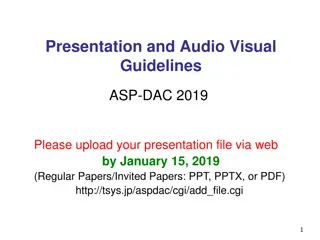New Global Economic Governance and Currency Multi-Polarity: The Changing Landscape
The world is undergoing radical transformations in economic governance and currency dynamics, signifying the end of old orders. Academic perspectives vary on the current state of global affairs, with discussions on an unsettled order and upheavals in power relations. Pervasive reforms within G7, G20, IMF, and MDBs are shaping the new economic landscape, emphasizing inclusiveness and experimentation. The emergence of social media is also influencing national and international relations. Despite daunting challenges, recent crises have led to significant changes towards multi-polarity and enhanced policy coordination effectiveness.
Download Presentation

Please find below an Image/Link to download the presentation.
The content on the website is provided AS IS for your information and personal use only. It may not be sold, licensed, or shared on other websites without obtaining consent from the author.If you encounter any issues during the download, it is possible that the publisher has removed the file from their server.
You are allowed to download the files provided on this website for personal or commercial use, subject to the condition that they are used lawfully. All files are the property of their respective owners.
The content on the website is provided AS IS for your information and personal use only. It may not be sold, licensed, or shared on other websites without obtaining consent from the author.
E N D
Presentation Transcript
New global economic governance and currency multi-polarity Carlo Monticelli Vice-Governor Council of Europe Development Bank
The world as we know has come to an end Radical transformation with continuity 3
An unsettled order Radical, unsettled reform in governance Some academics disagree: Drezner: The System Worked Helleiner: Status Quo Crisis Unsettled order, but order Some academics disagree: Bremmer & Roubini: G-Zero World Temin and Vines: The Leaderless Economy 4
Brave new (old) world Upheaval of power relations in global economy % of World GDP Levels from 18th century 100% 90% 80% 70% 60% 50% 40% 30% 20% 10% 0% 1900 1975 1992 2008 2017 2050 G7 G20 without G7 Rest of World There is no turning back 5
Pervasive reform G7 G20 IMF More power in the "old" MDBs Creation of two new ones (NDB + AIIB) MDBs FSB and SSBs with the new powers as members (but still rule-taking) FSF Weak role in the reform (myopic and fractious inwardness) Europe 6
The features of the new order Key features of the reform: Concern for inclusiveness in economic growth Purposeful experimentation Inter- Fragmentation connectedness Cross-cutting theme with a pervasive impact on national politics and international relations The social media revolution 7
Wrap up Daunting challenges while the global order remains unsettled in its architecture and institutional arrangements, yet better tools for global economic governance Never let a good crisis got to waste : the 2008 crisis was not wasted Radical change in the balance of power Remarkable enhancement of its legitimacy Considerable progress towards multi-polarity (even if Europe has been missing) New array of institutional and operational tools Enhanced flexibility and effectiveness of internationally-coordinated policy actions 8
Nationalism may, but need not, prevail Challenges might appear insurmountable, but the tools to address them are available provided that the international community finds the resolve to use them Currency multi-polarity is one of the tools 9
The 2008 crisis and the dollar The great financial crisis seemed to undermine the pivot role of the dollar: Gov. Zhou proposed replacing the dollar with SDR Uneasiness within both the G7 and the G20 Despite the severe and persistence imbalances, the dollar crash never materialized. In 2009 the world still viewed the dollar as a safe haven and as the pivot international currency 10
Several reasons for the exorbitant persistence of the dollar Structural power in global economy, rooted in US geopolitical dominance and enduring military supremacy Inertia in quoting and invoicing Absence of immediately viable alternatives Renminbi is not backed by deep and resilient financial markets and China s capital account and financial industry not yet liberalized Euro lacks adequate institutional background and political cohesion (also a cause of Europe s weak role in global financial governance) Dominance of the US banks in global finance (which in turn leads to an overwhelming influence on global regulatory standards) Direct access to the Federal Reserve s dollar facilities necessary to run a global business (chartered in the US subject to US regulation) 11
What is next? Fundamental factors undermining the dollar do remain and the process of reform in global governance is proceeding in earnest Persistent imbalances in flows and stocks Emerging markets greater economic and political weight, particularly China This time it s real Layne (2012) Dollar status still openly questioned (e.g. G20 Financial Safety Net WG) 12
Triffins dilemma today Considerable changes since Triffin s times: There is no longer a fundamental global liquidity shortage public and private sources of international liquidity The framework of International Monetary System has considerably changed (floating exchange rates) Appearance of credible alternatives to the dollar (even though not fully mature yet) But the tension between domestic policy concerns and global stability remains Triffin dilemma is alive and kicking Demand for safe assets US exorbitant privilege weaker market discipline Imbalances continued to mount, undermining the value of the dollar The elephant in the room: huge stock imbalances (most notably bilateral) 13
Transition to a brave new multipolar world Combination of a market-driven process and public management (otherwise risk of financial stability e.g. Woodford, 1990) Euro and renminbi: Slowly but surely coming of age (Mercury mostly there; maybe Eirene rather than Mars) International role of the euro, is one of the reasons why a stronger Europe is good for the world (there are others too) 14
Conclusion Global governance is undergoing a deep transformation, setting the stage for a multi-polar currency system A multi-polar currency system: Gradual, by its nature, with the dollar still remaining for a long time first among equals (precedent of the long decline of the pound) Combination of a market driven process and public guidance (Woodford, 1990) Can the SDR help address the problem of stock imbalances? Euro and the renminbi slowly but surely coming of age 15
Flow imbalances Current account balance (% of GDP) 10 8 6 4 2 0 1998 1999 2000 2001 2002 2003 2004 2005 2006 2007 2008 2009 2010 2011 2012 2013 2014 2015 2016 2017 -2 -4 -6 US Germany China Sources: OECD (2019) 16
Stock imbalances NFA position (to GDP) 50% 40% 30% 20% 10% 0% 1981 1983 1985 1987 1989 1991 1993 1995 1997 1999 2001 2003 2005 2007 2009 2011 2013 2015 -10% -20% -30% -40% -50% US Germany China Sources: Lane and Milesi-Ferretti (2017) 17
Stock imbalances NFA position (in billions of current US dollars) 2000 1000 0 1981 1983 1985 1987 1989 1991 1993 1995 1997 1999 2001 2003 2005 2007 2009 2011 2013 2015 -1000 -2000 -3000 -4000 -5000 -6000 -7000 -8000 US Germany China Sources: Lane and Milesi-Ferretti (2017) 18























